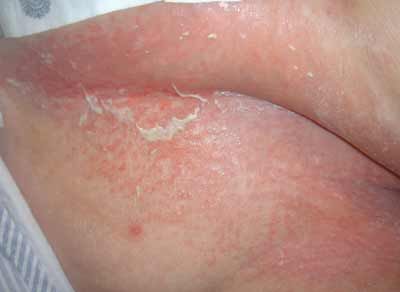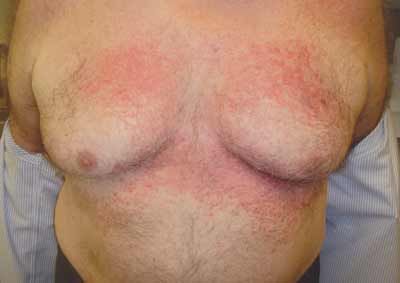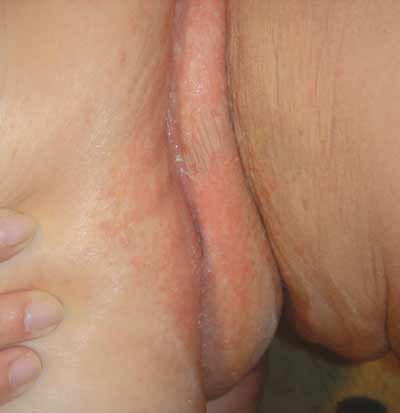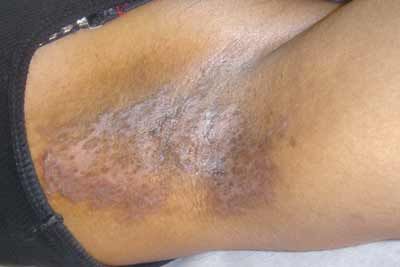Cutaneous Candidiasis
This infection is usually caused by Candida albicans, whichis often present in body folds. Candidiasis is common in persons with diabetes and in obese persons. Other predisposing factors are the use of antibiotics, topical corticosteroids, or immunosuppressive drugs; poor nutrition; and immunosuppression.
Cutaneous CandidiasisOral CandidiasisPerlche Erosio Interdigitalis BlastomyceticaOnychomycosisTinea PedisTinea CorporisTinea ManuumFungal Folliculitis
Cutaneous Candidiasis
This infection is usually caused by Candida albicans, which is often present in body folds. Candidiasis is common in persons with diabetes and in obese persons. Other predisposing factors are the use of antibiotics, topical corticosteroids, or immunosuppressive drugs; poor nutrition; and immunosuppression.

Figure 1 –
This scaly, erythematous rash manifested under the pannus of an obese patient's stomach as a result of a candidal infection.

Figure 2 –
Candidiasis manifested on this man's torso.

Figure 3 –
Intertrigo frequently coexists with candidiasis. Both disorders are facilitated by prolonged occlusion with moisture and warmth in skin flexures.

Figure 4 –
This reddish brown rash is erythrasma, which has a predilection for intertriginous areas.
Candidiasis usually appears as well-defined erythema with slight scaling, often accompanied by satellite papules and pustules. It most commonly occurs in the axilla, the groin, under the pannus of the stomach of obese persons (Figure 1), and the inframammary areas and other regions of the torso (Figure 2). Cracking and maceration of the skin may be present.
In many patients, candidiasis coexists with intertrigo (Figure 3); this inflammatory dermatosis results from the impairment of epidermal integrity and is not an infection. Both candidiasis and intertrigo are most pronounced in body folds. These disorders are facilitated by local factors, such as prolonged occlusion with moisture and warmth in skin flexures. Nutritional deficiencies may alter host defense mechanisms or epithelial barrier integrity, which allows increased adherence or penetration by Candida.
Erythrasma, which is caused by Corynebacterium minutissimum, also has a predilection for intertriginous areas; it typically manifests as reddish light brown or brown, smooth to slightly scaly patches in the groin and axilla (Figure 4). This infection can sometimes be diagnosed by Wood light examination (which reveals coral-red fluorescence) or by skin biopsy.
Potassium hydroxide evaluation is the easiest and most cost- effective method for diagnosing cutaneous candidiasis. Culture from an intact pustule, skin biopsy tissue, or desquamated skin can help support the diagnosis.
Treat coexisting candidiasis and intertrigo with drying agents, such as nystatin powder and Polysporin (bacitracin) powder, and an antifungal agent such as ciclopirox, which has anti-inflammatory effects. Severe candidiasis can be treated with oral fluconazole, 200 mg/d for 3 days or 100 mg/d for 1 week; sometimes only one dose of fluconazole is needed to clear candidiasis.
References:
FOR MORE INFORMATION:
- Brodell RT, Elewski B. Superficial fungal infections. Errors to avoid in diagnosis and treatment. Postgrad Med. 1997;101(4):279-287.
- Loo DS. Onychomycosis in the elderly: drug treatment options. Drugs Aging. 2007;24:293-302.
- Tan JS, Joseph WS. Common fungal infections of the feet in patients with diabetes mellitus. Drugs Aging. 2004;21;101-112.
- Weinberg JM, Scheinfeld NS. Cutaneous infections in the elderly: diagnosis and management. Dermatol Ther. 2003;16:195-205.
- Weinberg JM, Vafaie J, Scheinfeld NS. Skin infections in the elderly. Dermatol Clin. 2004;22:51-61.